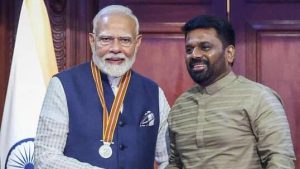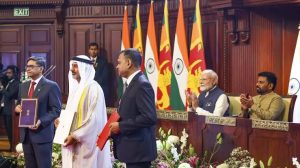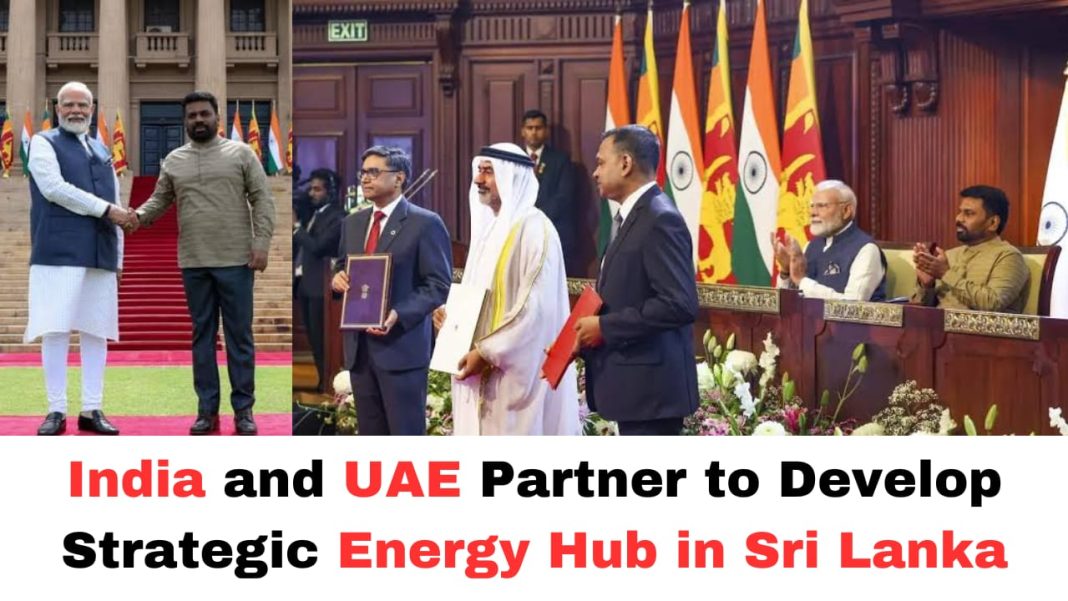Digital News Guru National Desk:
In a significant development highlighting the deepening geopolitical ties in the Indian Ocean region, India and the United Arab Emirates (UAE) have joined hands to develop a strategic energy hub in Sri Lanka. The agreement, signed during Indian Prime Minister Narendra Modi’s visit to Colombo on April 5, 2025, marks a pivotal moment in trilateral cooperation between India, the UAE, and Sri Lanka. It also signals a proactive response to China’s increasing influence in the island nation, particularly in key infrastructure and energy sectors.
The Trincomalee Energy Hub: Strategic and Symbolic
The core of the project lies in Trincomalee, a historically significant port city on Sri Lanka’s eastern coast. Once a World War II-era oil storage facility used by the British, the Trincomalee oil tank farm is now being repurposed to support South Asia’s growing energy demands. The India-UAE-led development will modernize this facility and build a multi-product pipeline system that can handle various types of fuels and energy resources.

The Trincomalee project is not just about oil or fuel; it is a symbol of regional solidarity and a calculated move in the broader geopolitical chessboard. India’s Indian Oil Corporation (IOC), through its Sri Lankan subsidiary, already co-manages a portion of the tank farm. The inclusion of the UAE, a wealthy Gulf oil power, adds both financial muscle and international legitimacy to the venture.
This initiative is particularly important as energy demands in South Asia continue to rise, and securing reliable and regional energy infrastructure becomes critical. The hub will likely include storage, refining, and possibly green energy capabilities in the future—providing flexibility and resilience to all three partner nations.
India’s Strategic Intentions
India’s involvement in the Trincomalee project is part of its long-term strategy to counterbalance China’s presence in the Indian Ocean Region (IOR). Over the past decade, China has invested heavily in Sri Lanka, including in projects like the Hambantota Port and a $3.2 billion oil refinery in the south, spearheaded by the Chinese state-owned Sinopec.
By establishing a presence in the strategically located Trincomalee, India ensures that it maintains access to vital sea lanes and strengthens its maritime security. The hub also supports India’s “Neighbourhood First” policy and enhances its credibility as a development partner that respects the sovereignty and economic interests of its neighbors.
Prime Minister Modi’s visit, the first by any head of state since Sri Lankan President Anura Kumara Dissanayake took office, further emphasizes the importance New Delhi places on its relationship with Colombo. Modi’s participation in the project launch, along with the inauguration of a 120-megawatt solar power plant, showcases India’s commitment to fostering sustainable and mutually beneficial economic partnerships.

The UAE’s Role and Interests
The UAE’s involvement in this project is a noteworthy evolution of its South Asian policy. Traditionally focused on Gulf and Western markets, the UAE has, in recent years, expanded its influence eastward. Partnering with India in a high-profile project like the Trincomalee hub allows the UAE to diversify its economic partnerships, ensure energy market access, and gain a foothold in the fast-growing South Asian region.
Moreover, the UAE’s presence can help ensure that the project receives adequate funding and operates with commercial efficiency. It also introduces a stabilizing force in Sri Lanka’s development matrix, offering an alternative to Chinese capital, which has often been accompanied by debt concerns and strategic dependencies.
Sri Lanka’s Strategic Pivot
For Sri Lanka, the Trincomalee energy hub represents an opportunity to rebalance its foreign relations. After facing a severe financial crisis in 2022, which saw the nation nearly defaulting on its debts and turning to India for $4 billion in emergency assistance, Sri Lanka is now trying to diversify its partnerships and reduce over-reliance on any one nation.
President Dissanayake’s government has shown interest in attracting investment that aligns with long-term national interests. The trilateral energy partnership offers the promise of improved energy security, job creation, infrastructure development, and a more diversified investment portfolio.
Moreover, positioning itself as a regional energy hub enhances Sri Lanka’s standing in the Indian Ocean, transforming it from a passive recipient of foreign aid to a proactive player in regional commerce and security.
Geopolitical Implications
The development of the Trincomalee hub must be viewed within the broader Indo-Pacific strategy. The region has become a focal point of global strategic competition, particularly between the U.S.-backed Quad alliance (India, the U.S., Japan, and Australia) and China’s Belt and Road Initiative (BRI). By establishing this hub, India and its allies are signaling a commitment to regional cooperation based on transparency, sustainability, and mutual benefit.
It also aligns with the India-Middle East-Europe Economic Corridor (IMEC), a connectivity project involving India and the UAE, announced in 2023. If integrated well, Trincomalee could become a key logistics and energy node in this growing corridor, enhancing trade and energy flows across continents.

Conclusion
The India-UAE-Sri Lanka trilateral initiative to develop an energy hub in Trincomalee is more than just an infrastructure project. It’s a strategic maneuver to reshape the dynamics of influence in the Indian Ocean Region. As energy, security, and geopolitical stakes rise, this collaboration offers a model of inclusive regional cooperation that balances development with national sovereignty.
If executed effectively, the Trincomalee Energy Hub could become a cornerstone of South Asia’s energy future—and a potent symbol of how nations can work together to ensure security, prosperity, and strategic balance in an increasingly competitive world.
You May Also Read: Supreme Court Cancels 25,753 Teacher Appointments in West Bengal








